DT250 (250Ω)
back to Beyerdynamic
back to measurements
home
published: Jul-13-2014, updated Sept-19-2022
NO SMOOTHING is applied to the shown plots. Most measurement sites have some smoothing applied which ‘irons flat’ sharp peaks and ‘wiggles’. I do not use smoothing because some info about sound quality is lost when plots are smoothed.
Aside from a small correction of the microphone itself also some correction in the lowest frequencies is applied to the plots to compensate for the perceived loss of bass when using headphones. This is described HERE in more detail.
A ‘horizontal‘ frequency response curve on the shown frequency response plots on this website thus indicates a perceived ‘flat’ tonal signature.
ALL measurements are made with a good SEAL on a flatbed measurement rig.
The shape of your head, bone structure, pad size, pad ‘softness, (compliance), hair or no hair and or wearing glasses may (drastically) change the frequency response of some headphones, so… your personal experience may differ substantially from these plots.
Frequency response (tonal balance) is the most sound-determining aspect of headphones. A horizontal line shows audible neutral response in the plots on this website. Deviations in different severities at different frequency bands have an effect on the sound character.
The bigger the deviation the stronger the effect.
Below an aid to help determining the sound character of headphones with relation to the frequency response.

Beyerdynamic DT250 – 250 Ohm

The Beyerdynamic DT250/250 is a headphone intended for professional usage. This means it is modular, in that a microphone can be fitted and that it is a rugged headphone with a rather high clamping force.
It has soft and comfortable velours earpads and if it weren’t for the clamping force, which is higher than for ‘hifi’ headphones, it could be worn for long listening sessions. Very light-weight headphone as well.
The headphone is fully closed and provides excellent isolation from outside noises (yet another pro feature).
The headband has replaceable padding. Clamping force is rather high which is not that strange for studio usage.
The pads are velour and not particular roomy. The depth is 19mm so the pinna is likely to touch the headphone. 55mm internal height and 29mm width also is nothing to write home about.
The cable has a 7-pin connector in the headphone which allows for balanced connections and a microphone. The supplied cable is coiled, kind of heavy (110g) and can stretch from 1.5m to 3m.
It is somewhat microphonic.
This is one of these affordable (€ 150.-) headphones that is worth owning if you like a realistic sound and are on a budget and only need/want one headphone. An alternative is the DT150 (250Ω) with EDT100T pads or (with a less sturdier build quality) the AKG K361.
There is some imbalance between L and R cup which can be fixed (see further down in the article)
specifications:
Type: Over ear, semi-closed
Usage: Home, studio
Driver type: dynamic
Pads: replaceable, velours
Isolation: decent, ± 16dBA
Collapsible: No
Headphone cup connector: Beyerdynamic 7-pin
Cable entry: single sided (left).
Cable: 3m coiled cable terminated in a 3.5mm TRS jack with a 6.3mm adapter
Driver size: 40mm
Inner Pad dimensions: height = 55mm, width = 29mm, depth = 19mm
Max. power rating: 0.1W
Max. voltage: 5Vrms (14Vpp)
Max. current: 21mA
Max. S.P.L.: 121dB
Impedance: 235Ω (measured)
Efficiency: 101dB @ 1mW
Sensitivity: 107dB @ 1V
Weight: 240 g. (excl. cable)
Clamping force: high (4.5N)
Subjective sound description:
The sound is neutral and accurate though lacks a certain finesse in the treble compared to the top-end headphones.
Bass is present at the correct level and is not overblown or rolled-off. The bass quality is good.
Mids sound realistic and balanced.
The treble is at the correct level but lacks ‘finesse’ and ‘smoothness’ and is a bit ‘coarse’ sounding but does show what is in the recording.
Those looking for a reference tonal balance headphone that exactly shows what’s in the recording these headphones will do very well.
Measurements:
The frequency plot below shows some driver imbalance. This imbalance is caused by leakage of the cable entry being present only on the left side.
Otherwise a great looking and neutral frequency response that is ‘flat’ from 10Hz to 18kHz +/-3dB. (left, right)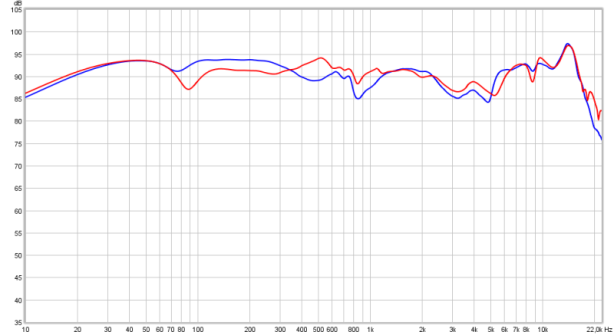
Bass extension is excellent. Mids are neutral, highs are not elevated and well extended.
Below the frequency response of a second one that was measured (after ‘tuning’ see below). As can be seen not all DT250-250 are created equal and may be a bit of a lottery.
As can be seen not all DT250-250 are created equal and may be a bit of a lottery.
Both headphones sound ‘balanced’ in tonal aspect and have mediocre treble quality.
phase response
Below the phase response of the DT250-250 (left, right) Gentle sloping phase shifts are not audible. Pad-bounce (80Hz) is showing some steep changes over a small bandwidth. Also some steep but not high magnitude phase shifts around 1kHz and 7kHz.
Gentle sloping phase shifts are not audible. Pad-bounce (80Hz) is showing some steep changes over a small bandwidth. Also some steep but not high magnitude phase shifts around 1kHz and 7kHz.
output resistance / damping-factor
As this is a dynamic headphone the frequency response can be amplifier output resistance dependent when certain higher output resistance amplifiers are used.
Instead of showing impedance plots, which are hard to ‘read’ when it comes to assessing the tonal balance change in the real world, the DT250-250 is measured via a few different resistance outputs (0.2Ω, 10Ω, 33Ω and 120Ω). On a higher output resistance amplifier the output level will be lower of course due to voltage division. To compensate for this the amplifier is cranked up to the same level (3.3dB for 120Ω at 1kHz in this case). This way the plots are overlaid and it is easier to see how the tonal balance changes.
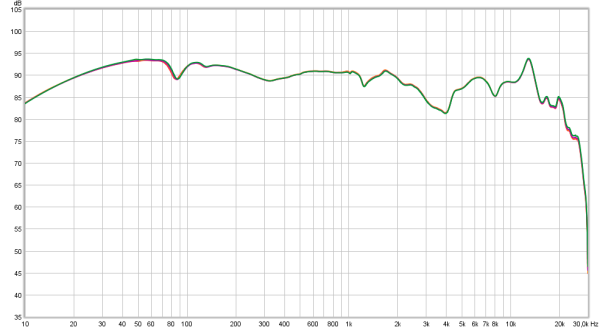 The tonal balance hardly changes when the DT250-250 is connected to a higher output resistance amplifier. So connecting it to studio gear with unknown output resistances (headphone outs are usually a low quality afterthought) will not lead to different tonal balance.
The tonal balance hardly changes when the DT250-250 is connected to a higher output resistance amplifier. So connecting it to studio gear with unknown output resistances (headphone outs are usually a low quality afterthought) will not lead to different tonal balance.
seal
Seal can be an issue with closed-back headphones. Breaking the seal (improper fit on the head) usually means a loss of (sub)bass. Perfect seal, seal broken with a thick arm pair of glasses and seal broken by thick arm glasses not resting against the skin and finally seal broken by slightly lifting the bottom of the pads which can occur when not properly seated.
The DT250-250 is quite insensitive to a seal breach due the semi-closed principle (pads ‘leaking’ a bit). People wearing glasses are greeted with the same amount of lows as the ones having a perfect seal.
Only bass extension is somewhat affected.
Below the distortion measurements of the DT250-250 (Right channel).
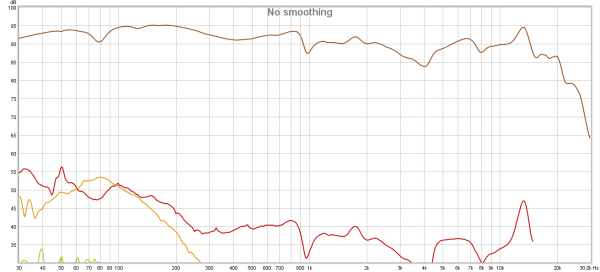 The plot above shows the level differences between the signal (upper trace around 90dB SPL) and the harmonics. Most people prefer to see percentages instead of level differences so below the exact same plot except ‘normalized’ to the actual signal and level differences given in percentages.
The plot above shows the level differences between the signal (upper trace around 90dB SPL) and the harmonics. Most people prefer to see percentages instead of level differences so below the exact same plot except ‘normalized’ to the actual signal and level differences given in percentages.
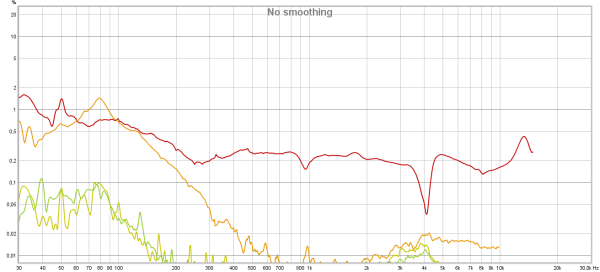 Distortion levels in the lowest frequencies are mainly 2nd harmonic above 250Hz distortion drops below 0.2% which is good for a driver of this size. The 3rd harmonic are also high which indicates some compression.
Distortion levels in the lowest frequencies are mainly 2nd harmonic above 250Hz distortion drops below 0.2% which is good for a driver of this size. The 3rd harmonic are also high which indicates some compression.
The actual 2nd harmonic distortion above 300Hz may well be lower than 0.2% . A shortcoming of my measurement rig.
Below the CSD (waterfall) plot of the DT250-250. (Left and Right are overlaid)
Below 2kHz damping is not that great. This may be related to the cups being closed. Above 2kHz the driver is well damped and there are no long lasting resonances visible.
Below the Group Delay plot for the DT250/250 (Left, Right)
There is pad bounce at 80Hz and 130Hz. Around 300Hz and 900/1200Hz there are some resonances visible.
A different plot is the spectrum plot. This basically is a CSD (Waterfall) plot but viewed from above where the level differences are color coded instead of being in the vertical axis. Also the frequency range of the spectrum plot is wider (from 100Hz instead of 500Hz). The time span is also bigger in the spectrum plots and expired time is shown from below to top where in the CSD the time is shown from rear to front.
Below the spectrum plot of the DT250/250 (Right channel) Below 300Hz there is some longer than desired lingering going on (poor damping).
Below 300Hz there is some longer than desired lingering going on (poor damping).
Also around 1kHz there is a resonance, quite likely something inside the cups.
Step response
Below the step response plot which, when the sound is balanced and well extended should show a rise to around 0dB, (indicating fast driver response) and should be slightly sloping downwards indicating bass extension. (Left, Right)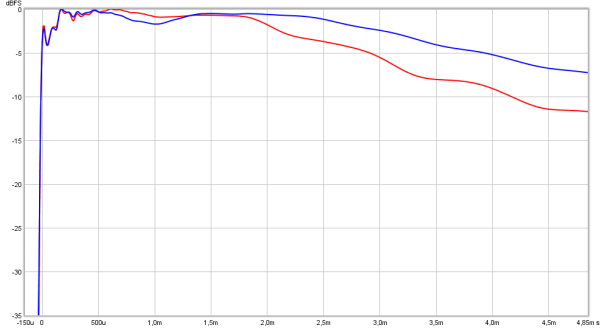 The excellent bass extension is evident as the horizontal trace only slopes downwards very gradually. The initial rise of the signal reaches -2dB level and the trace being horizontal between 150μs and 2ms is indicative of its neutral character.
The excellent bass extension is evident as the horizontal trace only slopes downwards very gradually. The initial rise of the signal reaches -2dB level and the trace being horizontal between 150μs and 2ms is indicative of its neutral character.
cable connector modification
The owner of the DT250 below wanted the 7-pin connector replaced by a 3.5mm TRS socket.
After removing the connector and it’s PCB a 3.5mm TRS socket was mounted on a small piece of black plastic. The socket was then fixed and sealed using hotmelt glue.
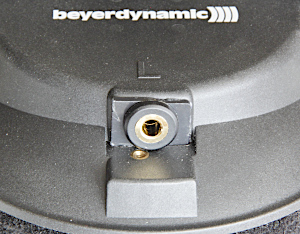

This modification also solved the ‘leakage’ issue with the connector. The original connector leaks some air around the connector. The right side is fully closed and does not have the leak.
There is an easy fix for this which is shown HERE by mounting some foam on the pins. It is not the pins that are leaking air but the space around the socket. The foam covers that leakage. Those that wonder about the screw that holds the connector in place, this is sealed from the inside with some hotmelt glue.
When this headphone arrived it had some work done on it.
Measurements of this DT250 as it arrived.
 It lacked bass extension and had an even bigger imbalance between 50Hz and 1kHz.
It lacked bass extension and had an even bigger imbalance between 50Hz and 1kHz.
I assumed this would go away when the connector was replaced and sealed but it didn’t and just differed a bit. One of the foam discs was cut off a bit near the edges. As can be seen from the link shown above this foam disc also makes a difference.
This triggered a search.
Pads were swapped = no difference.
Foam discs were swapped which gave a slight difference but not enough and not in the part of the frequency range that was affected. (see plot below, there are also differences in re-seating the headphone)
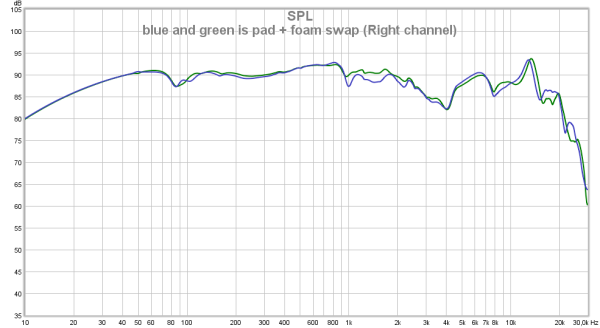 Changed the drivers (+ baffle) from left to right = no change.
Changed the drivers (+ baffle) from left to right = no change.
Both cups are equally sealed so added the same amount of hotmelt glue in the right cup in the same position = no change.
As the baffle is just resting on the cup and there is some space between it that edge of the baffle was sealed with sellotape.
This changed the response considerably and not for the better but was in the exact problem range but actually made things worse.
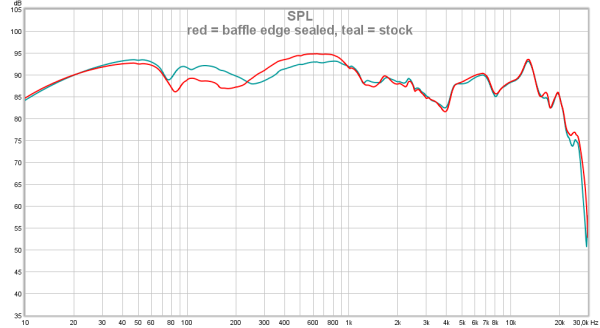 The question now was what differed between the left and right cup (both were now sealed) and why one side seemed less ‘leaking’ than the other side.
The question now was what differed between the left and right cup (both were now sealed) and why one side seemed less ‘leaking’ than the other side.
The trick seems to be to make the right cup (the side without the connector) leak a bit around the baffle.
The left side always has some leakage from the connector so Beyerdynamic had to find a way around that. A not all DT250’s seem to differ that much between L and R there has to be a tuning method.
After careful inspection of differences around the edge of the cup there appeared to be a plastic ‘ridge’ with a thin line on it protruding a little above the bottom screw-post.
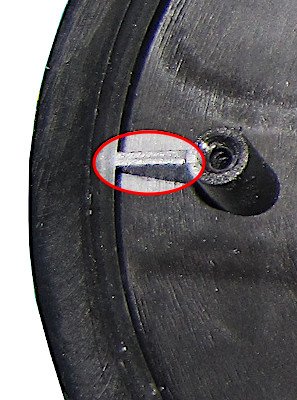 This small piece of plastic is shown highlighted in the red oval in the picture on the left. This ridge is not present on the left side.
This small piece of plastic is shown highlighted in the red oval in the picture on the left. This ridge is not present on the left side.
This ‘lifts’ the baffle slightly.
When the screw on the bottom of the baffle is tightened the edge of the baffle is slightly lifted. The more the screw is tightened the smaller the air-gap will be. This is a matter of thenths of mm and very difficult to see.
Below some measurements showing what happens when the screw is not tightened (but screwed down in the hole) to all the way down. (right cup).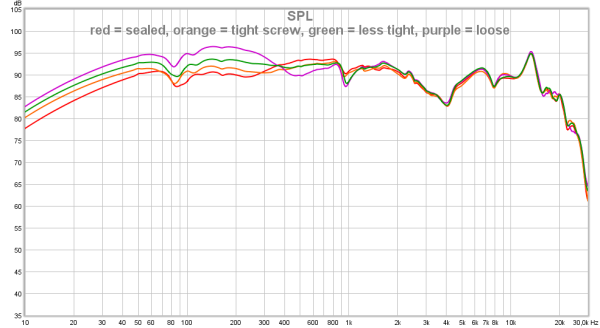
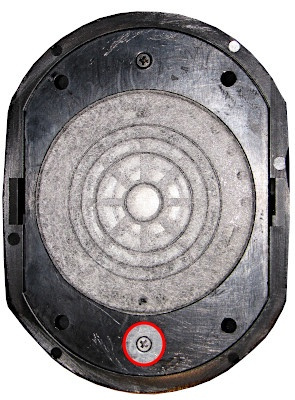
It appears as though this is a method to match the the left and right side due to a difference in ‘leakage’.
This is ranging from bassy (screw not tightened) all the way up to reduced bass.
The picture on the right shows the screw that is used to control intentional leakage (highlighted in the red circle).
The 4 holes in the corners are sealed by 4 pins on the pad mounting plate and do not leak any air.
To show how small of a ‘window’ there is to tune the frequency response is shown in the plot below where the screw is tightened in ¼ turn increments from a certain point.
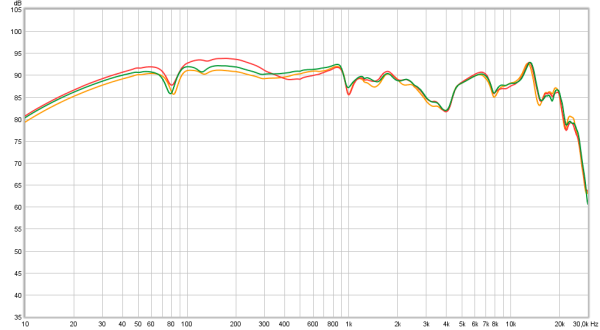 It would appear as though this tuning would have to be done in a factory while observing the frequency response. It also is not strange to believe that tuning method will not always remain the same as the plastic ‘ridge’ will compress over time creating the L-R difference seen in quite a few DT250’s.
It would appear as though this tuning would have to be done in a factory while observing the frequency response. It also is not strange to believe that tuning method will not always remain the same as the plastic ‘ridge’ will compress over time creating the L-R difference seen in quite a few DT250’s.
So.. when tinkering with this headphone only limit this to the left side (cable entry side) and leave the right side untouched unless there is an audible L-R balance issue. In which case loosening the screw may help.
pad wear
Another (heavily used DT250-80) had completely worn pads and missing foam discs as these had already disintegrated. The plot below shows what happens to the response when such pads are used.
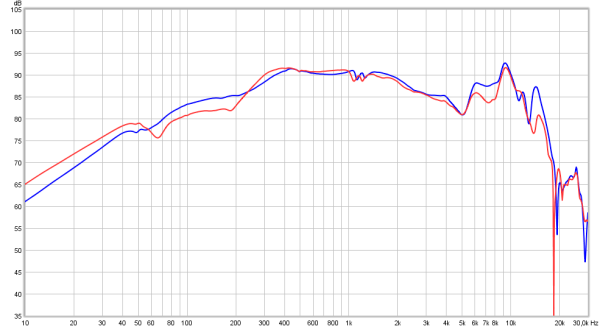 The owner did not want it fixed and replaced the headphones completely. Interestingly enough the same L-R imbalance was present here as well. The worn pads and missing foam discs make the bass roll-off quickly.
The owner did not want it fixed and replaced the headphones completely. Interestingly enough the same L-R imbalance was present here as well. The worn pads and missing foam discs make the bass roll-off quickly.
conclusion
Highly recommended for studio usage with a neutral sound signature. Sturdy and can take a beating. Pads, headband padding, cables, accessories are still supported.
An amplifier may be recommended when it has to play a bit louder as it is rather high impedance.
It will play from most headphone outputs found in studio gear up to at least comfortable listening levels.
Negatives are the rather high clamping force (for long term listening) and the less refined treble and limited room for the ears.
How well left and right cups are balanced is a bit of a lottery but overall the tuning from the factory when not too old should be O.K.
